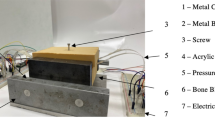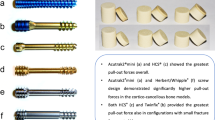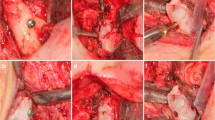Abstract
Introduction
Commonly used headless design screws such as Acutrak and Herbert screws have limited compressive effect on short fragment fixation. Therefore, we investigated whether preloaded compression techniques could be helpful in improving the compression effect.
Method
A prototype of interfragmentary compression screw was designed with a constant pitch to avoid self-compressive effect. Preloaded compression was achieved with a sleeve device before the insertion of the trailer side (the leading side was inserted). Prototype screw test results were compared with those of Acutrak and Herbert screws. Eight pullout and eight compression tests were performed for each of the three screws using homogenous synthetic bone blocks.
Results
The mean pullout forces of the Acutrak, Herbert and prototype screws were 67.21, 45.90 and 61.88 N, respectively. Preloaded compression (18.15 N) was higher than the compression produced by Acutrak (15.27 N) and Herbert (15.11 N) screws (p < 0.05). However, at the end of full insertion, half of the power obtained by preloaded compression was lost.
Conclusion
Preloaded compression technique was successful in attaining maximum compression rate. During trailing-side insertion, constant pitch design failed to keep compression rate. Variable pitches can be useful to preserve or increase compression rate. In addition, sleeve usage may be more advantageous in thin fragment fixation.





Similar content being viewed by others
References
Adla DN, Kitsis C, Miles AW (2005) Compression forces generated by Mini bone screws—a comparative study done on bone model. Injury 36(1):65–70
ASTM F1839 (1997) Standard specification for rigid polyurethane foam for use as a standard material for testing orthopaedic devices and instruments. American Society for Testing and Materials
Bailey CA, Kuiper JH, Kelly CP (2006) Biomechanical evaluation of a new composite bioresorbable screw. J Hand Surg Br 31(2):208–212
Beadel GP, Ferreira L, Johnson JA, King GJ (2004) Interfragmentary compression across a simulated scaphoid fracture–analysis of 3 screws. J Hand Surg Am 29(2):273–278
Brown GA, McCarthy T, Bourgeault CA, Callahan DJ (2000) Mechanical performance of standard and cannulated 4.0-mm cancellous bone screws. J Orthop Res 18(2):307–312
Chapman JR, Harrington RM, Lee KM, Anderson PA, Tencer AF, Kowalski D (1996) Factors affecting the pullout strength of cancellous bone screws. J Biomech Eng 118(3):391–398
Claes LE, Heigele CA, Neidlinger-Wilke C, Kaspar D, Seidl W, Margevicius KJ, Augat P (1998) Effects of mechanical factors on the fracture healing process. Clinic Orthop Relat Res (Suppl) 355:132–147
Faran KJ, Ichioka N, Trzeciak MA, Han S, Medige J, Moy OJ (1999) Effect of bone quality on the forces generated by compression screws. J Biomech 32(8):861–864
Galuppo LD, Stover SM, Jensen DG, WEillits NH (2001) A biomechanical comparison of headless tapered variable pitch and AO cortical bone screws for fixation of a simulated lateral condylar fracture in equine third metacarpal bones. Vet Surg 30(4):332–340
Galuppo LD, Stover SM, Jensen DG (2002) A biomechanical comparison of equine third metacarpal condylar bone fragment compression and screw pushout strength between headless tapered variable pitch and AO cortical bone screws. Vet Surg 31(3):201–210
Goldstein SA (1987) The mechanical properties of trabecular bone: dependence on anatomic location and function. J Biomech 20(11–12):1055–1061
Herbert TJ, Fisher WE (1984) Management of the fractured scaphoid using a new bone screw. J Bone Joint Surg Br 66(1):114–123
Huebner RJ, Conrad GL, Jensen DG (1999) Variable pitch bone screw USA Patent Document 5, 871, 486
Huebner RJ (2000) Axial tension screw. USA Patent Document 6, 030, 162
Johnson NL, Galuppo LD, Stover SM, Taylor KT (2004) An in vitro biomechanical comparison of the insertion variables and pullout mechanical properties of AO 6.5-mm standard cancellous and 7.3-mm self-tapping cannulated bone screws in foal femoral bone. Vet Surg 33(6):681–690
Lo IKY, King GJ, Milne AD, Johnson JA, Chess DC (1998) A biomechanical analysis of intrascaphoid compression using the Herbert scaphoid screw system. An in vitro cadaveric study. J Hand Surg Br 23(2):209–213
Lo IKY, King GJ, Patterson SD, Johnson JA, Chess DG (2001) A biomechanical analysis of intrascaphoid compression using the 3.00 mm Synthes cannulated screw and threaded washer: an in vitro cadaveric study. J Hand Surg Br 26(1):22–24
Rankin G, Kuschner SH, Orlando C, McKellop H, Brien WW, Sherman R (1991) A biomechanical evaluation of a cannulated compressive screw for use in fractures of the scaphoid. J Hand Surg Am 16(6):1002–1010
Shaw JA (1991) Biomechanical comparison of cannulated small bone screws: a brief follow-up study. J Hand Surg Am 16(6):998–1001
Siddiqui AA, Blakemore ME, Tarzi I (2005) Experimental analysis of screw hold as judged by operators v pullout strength. Injury 36(1):55–59
Wheeler DL, McLoughlin SW (1998) Biomechanical assessment of compression screws. Clin Orthop Relat Res 350:237–245
Author information
Authors and Affiliations
Corresponding author
Rights and permissions
About this article
Cite this article
Baran, O., Sagol, E., Oflaz, H. et al. A biomechanical study on preloaded compression effect on headless screws. Arch Orthop Trauma Surg 129, 1601–1605 (2009). https://doi.org/10.1007/s00402-009-0971-0
Received:
Published:
Issue Date:
DOI: https://doi.org/10.1007/s00402-009-0971-0




